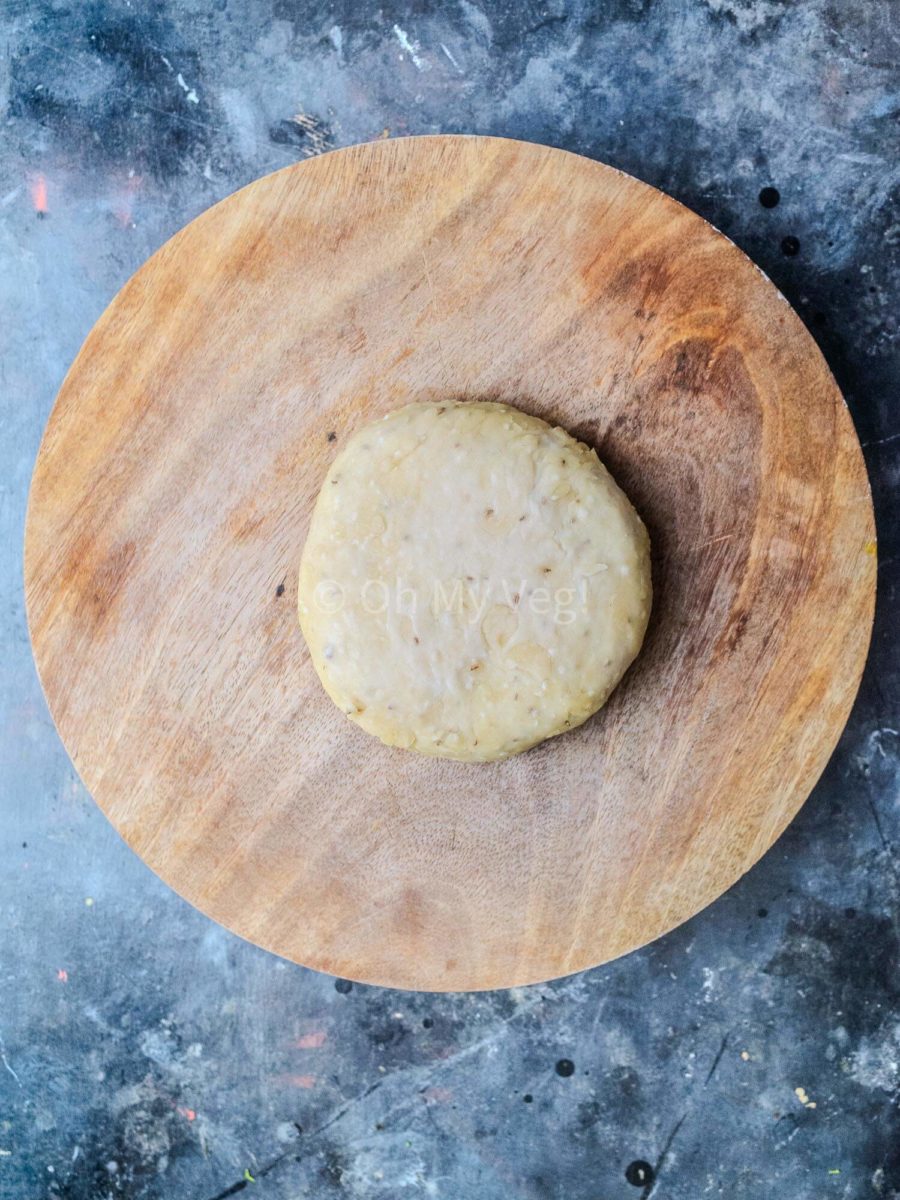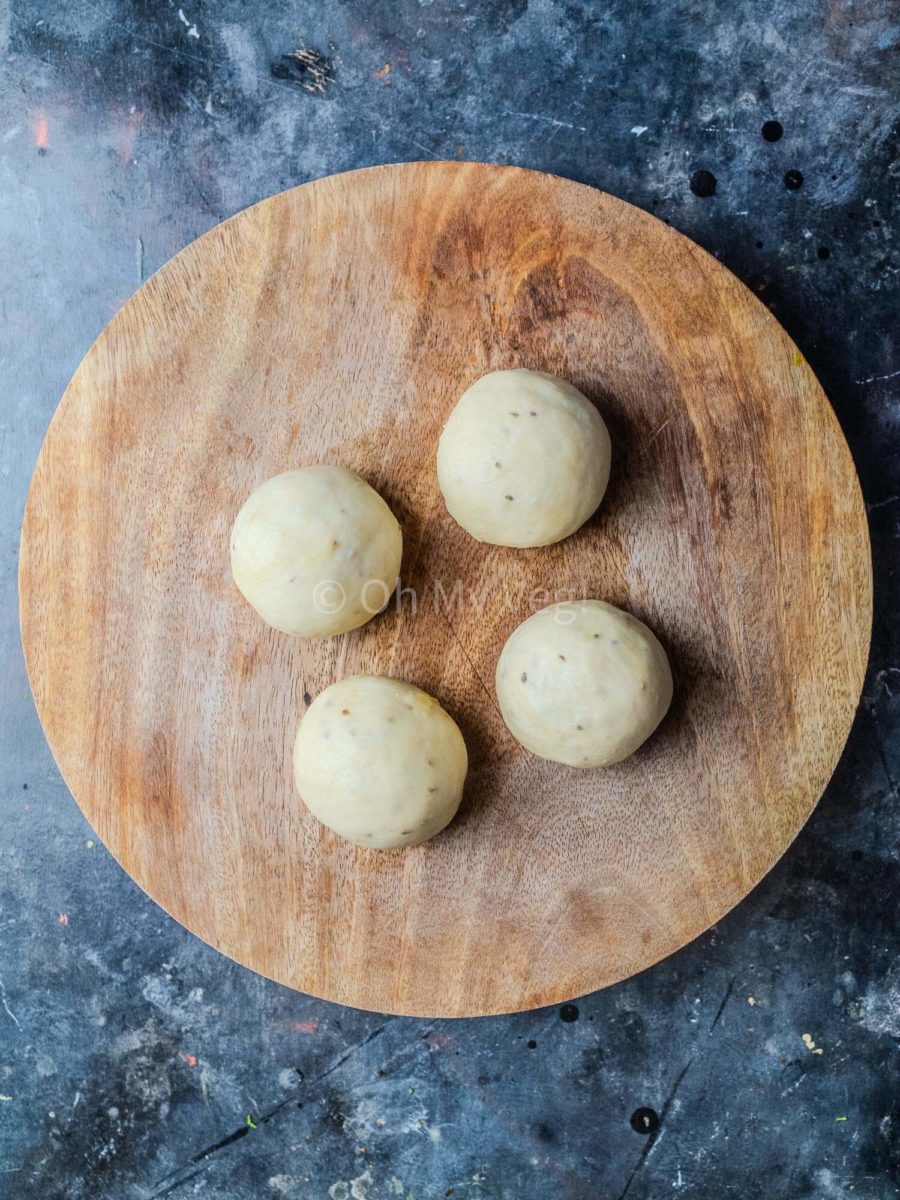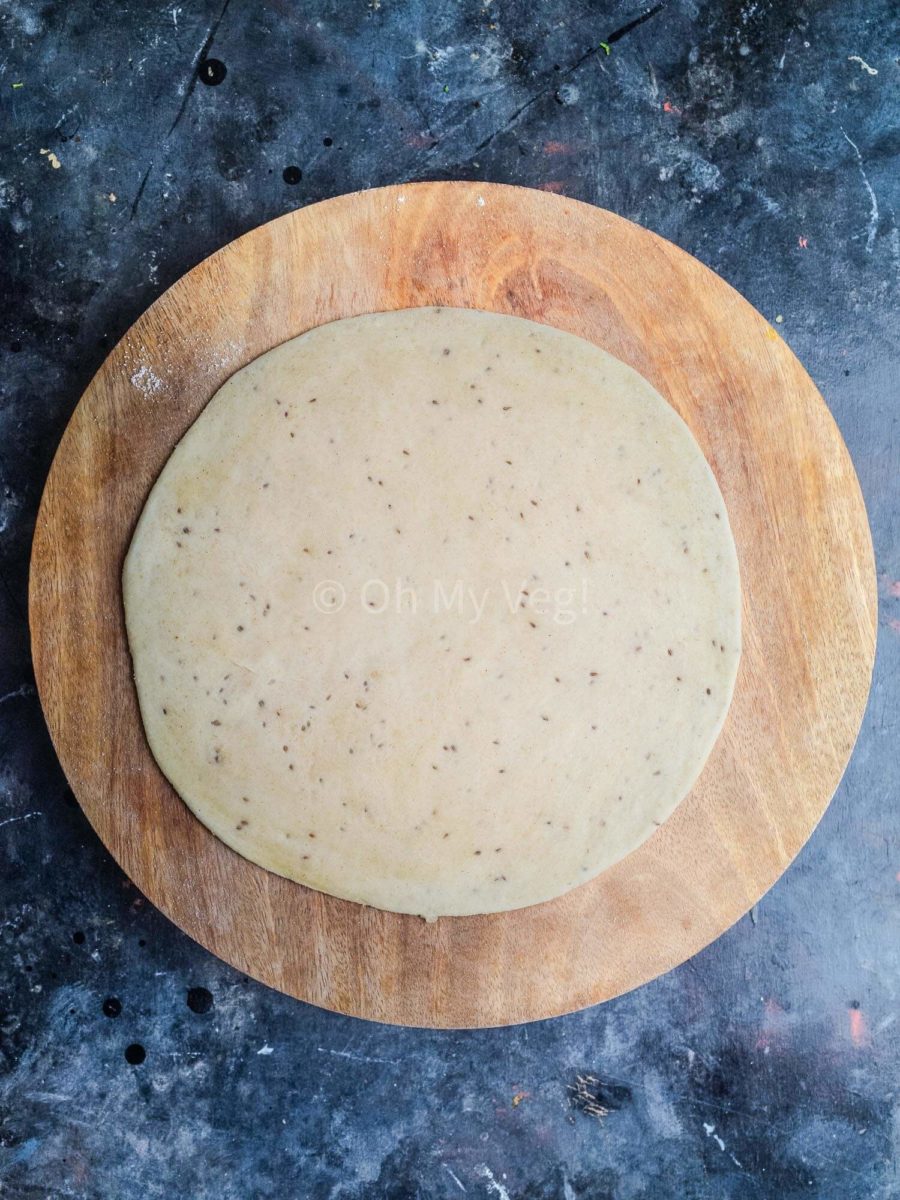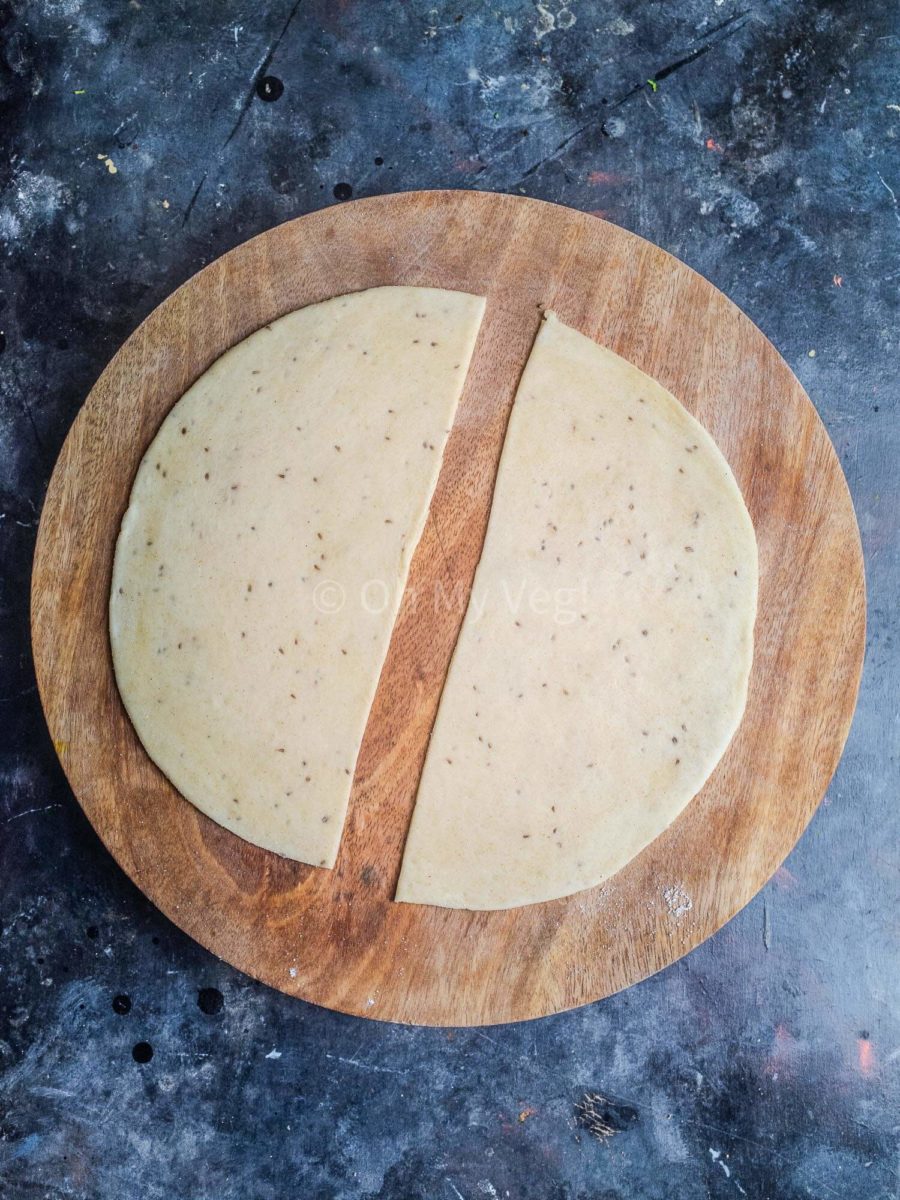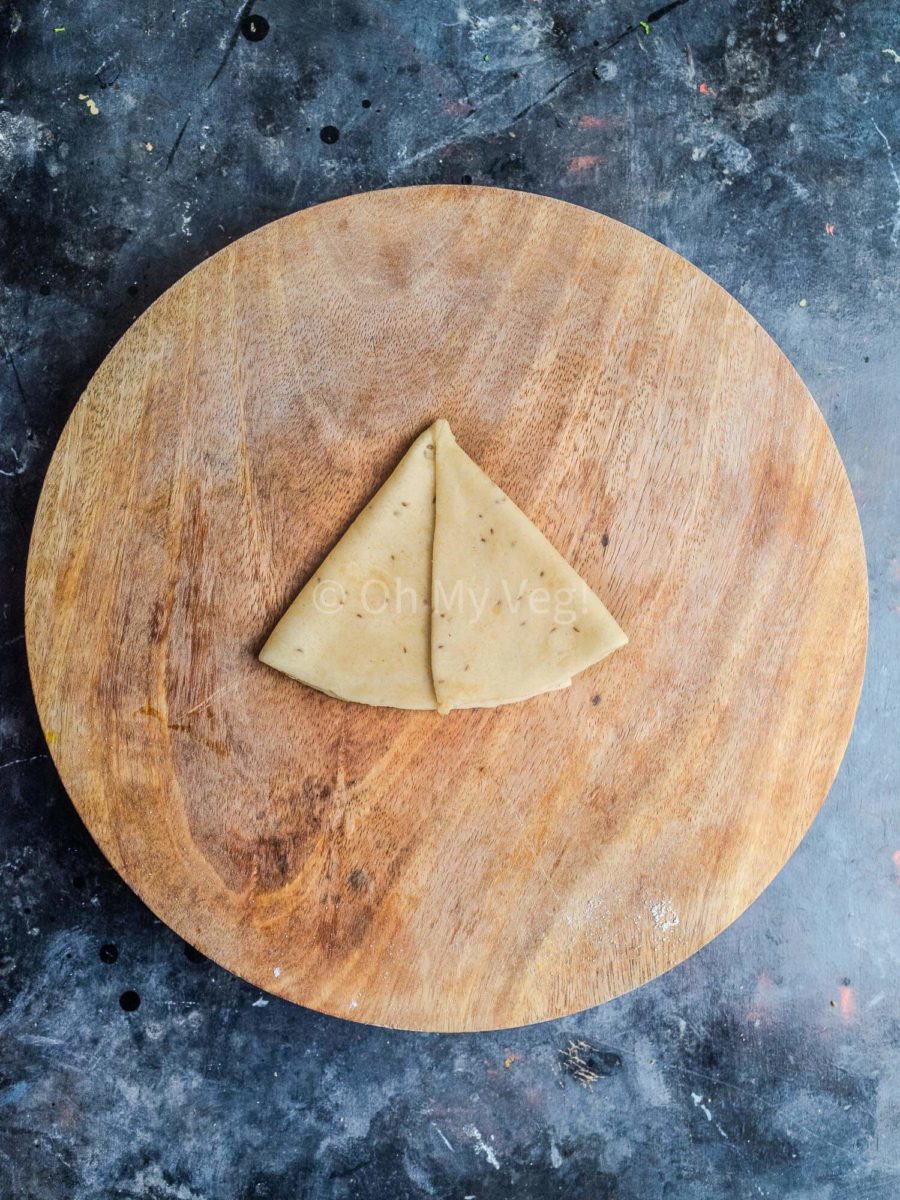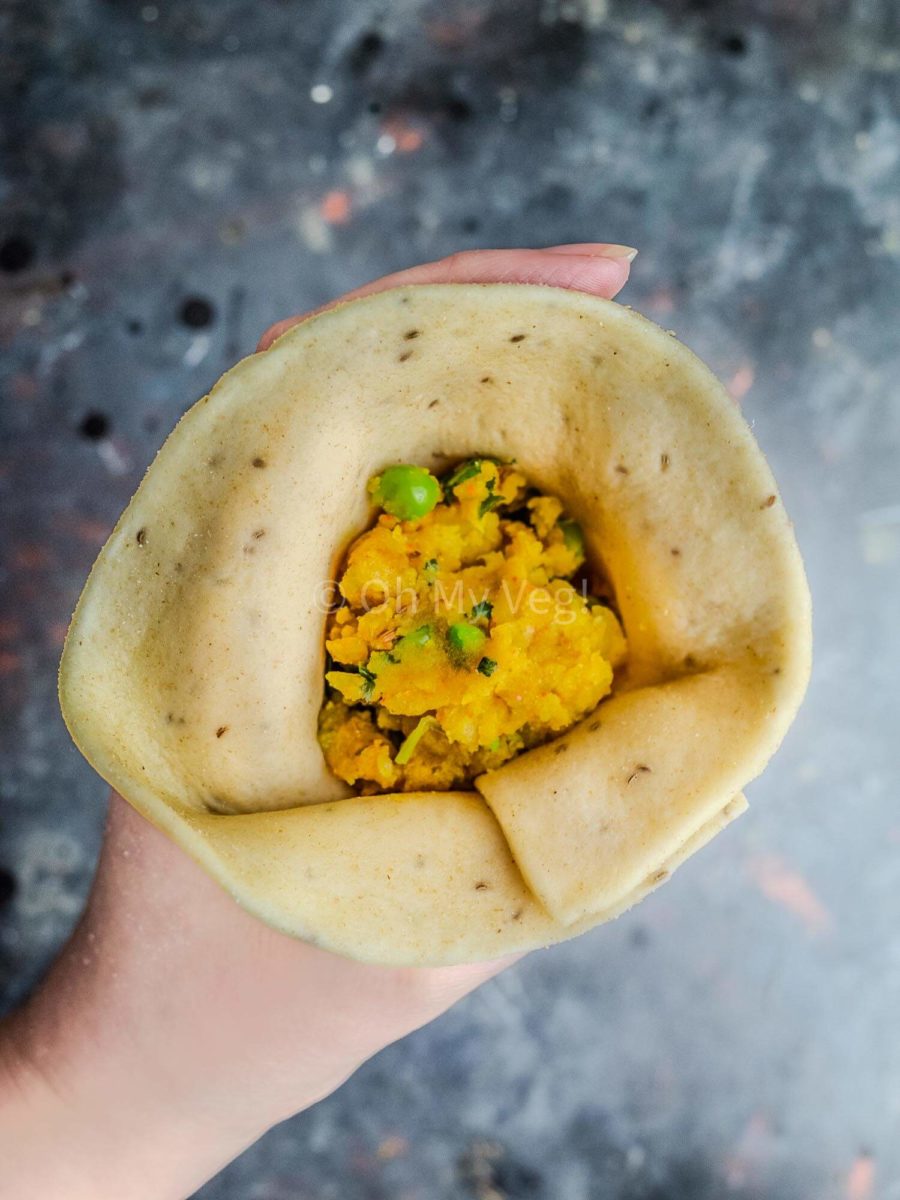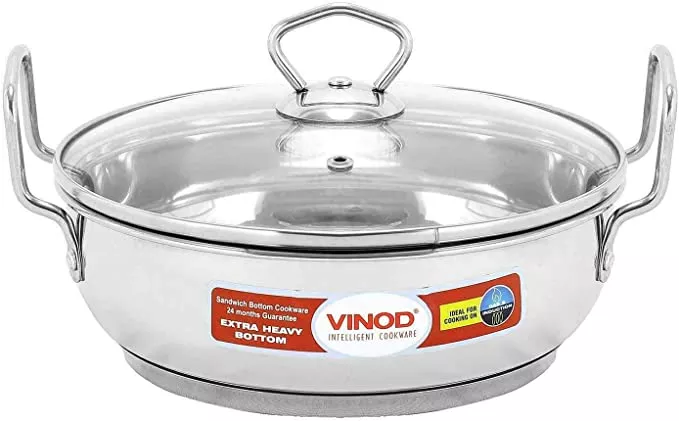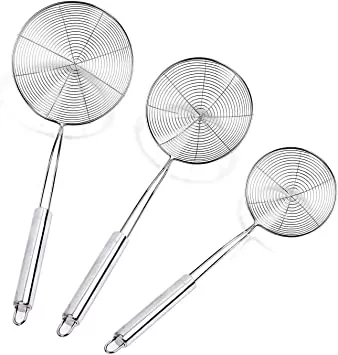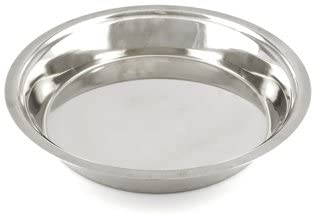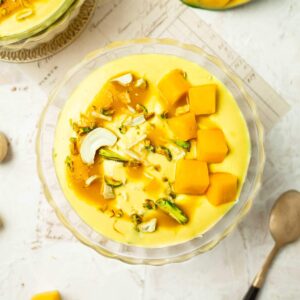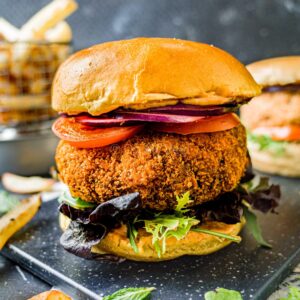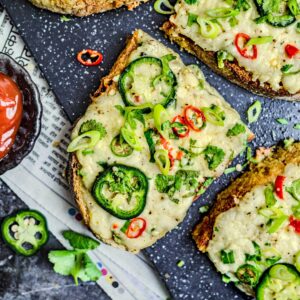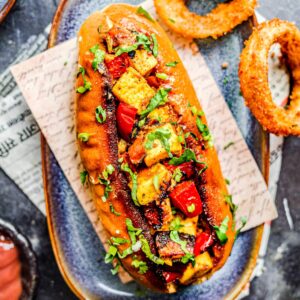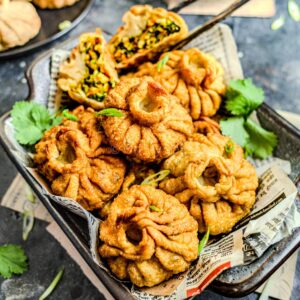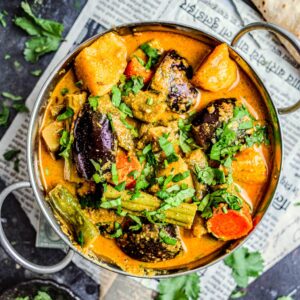Vegetable Samosa, Vegan Punjabi Samosa
Aside from onion bhaji, vegetable samosa are the most beloved and iconic Indian snack food — ever. It’s no wonder these vegan nibbles have garnered worldwide attention! My recipe is as traditional as possible, with the crispiest, flakiest, crunchiest, golden-brown homemade pastry you can imagine stuffed fit to burst with an expertly seasoned potato, pea, and sautéed onion filling.
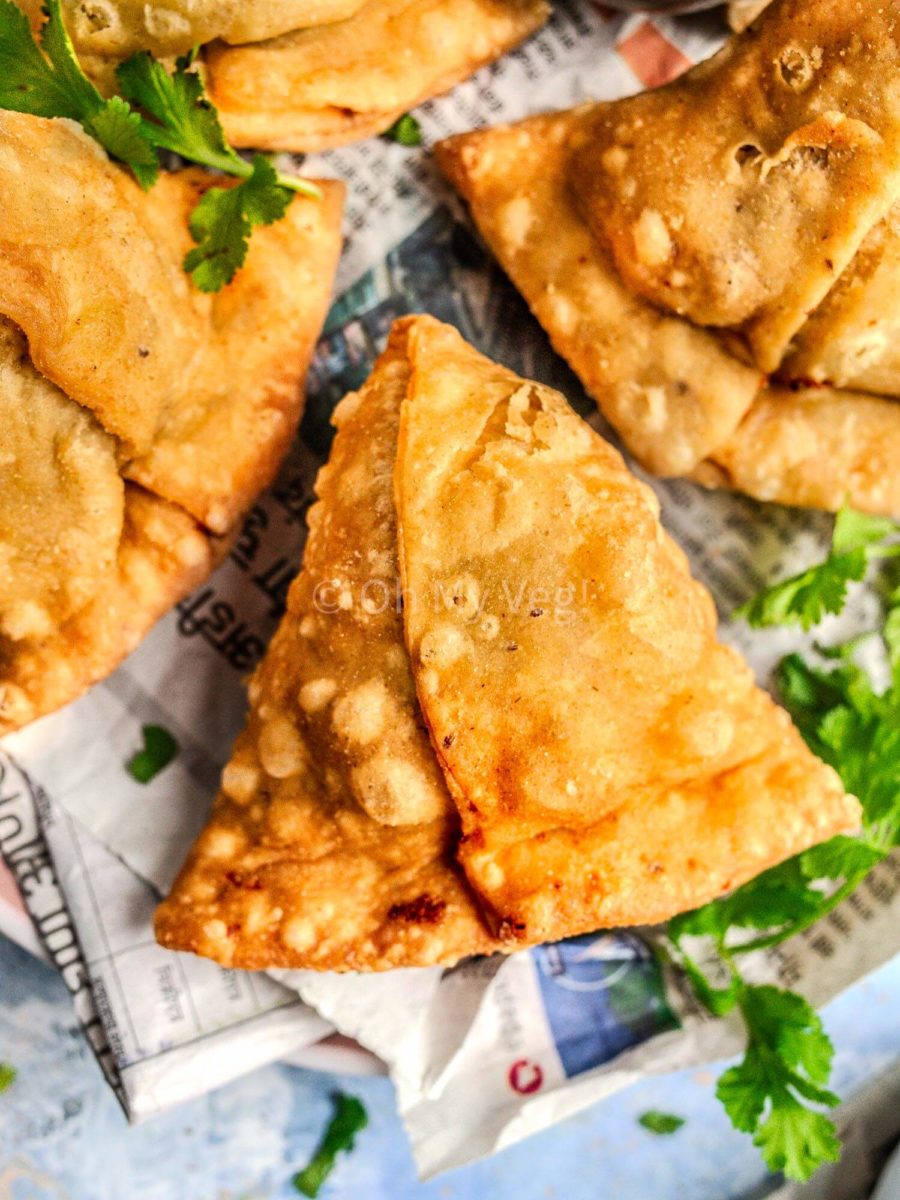
However, too often, stores only stock sad, flat filo samosas with the bare minimum of that scrumptiously spiced, moreish potato-based filling. Who wants those? As for restaurants, the Punjabi samosas can often be excessively oily and greasy. Similarly to other takeout classics like dal tadka, palak paneer, and garlic coriander naan, Punjabi samosa from scratch tastes infinitely better than anything you could dream of.
Plus, the good news? It’s entirely your choice whether you want to deep-fry the samosas for that characteristic bubbly, golden pastry or opt for a health-focused air-fried samosa or baked samosa. We’ve got instructions to make each of them! It’s easier than you might think — are you ready to learn how to make this vegetable samosa easy recipe?
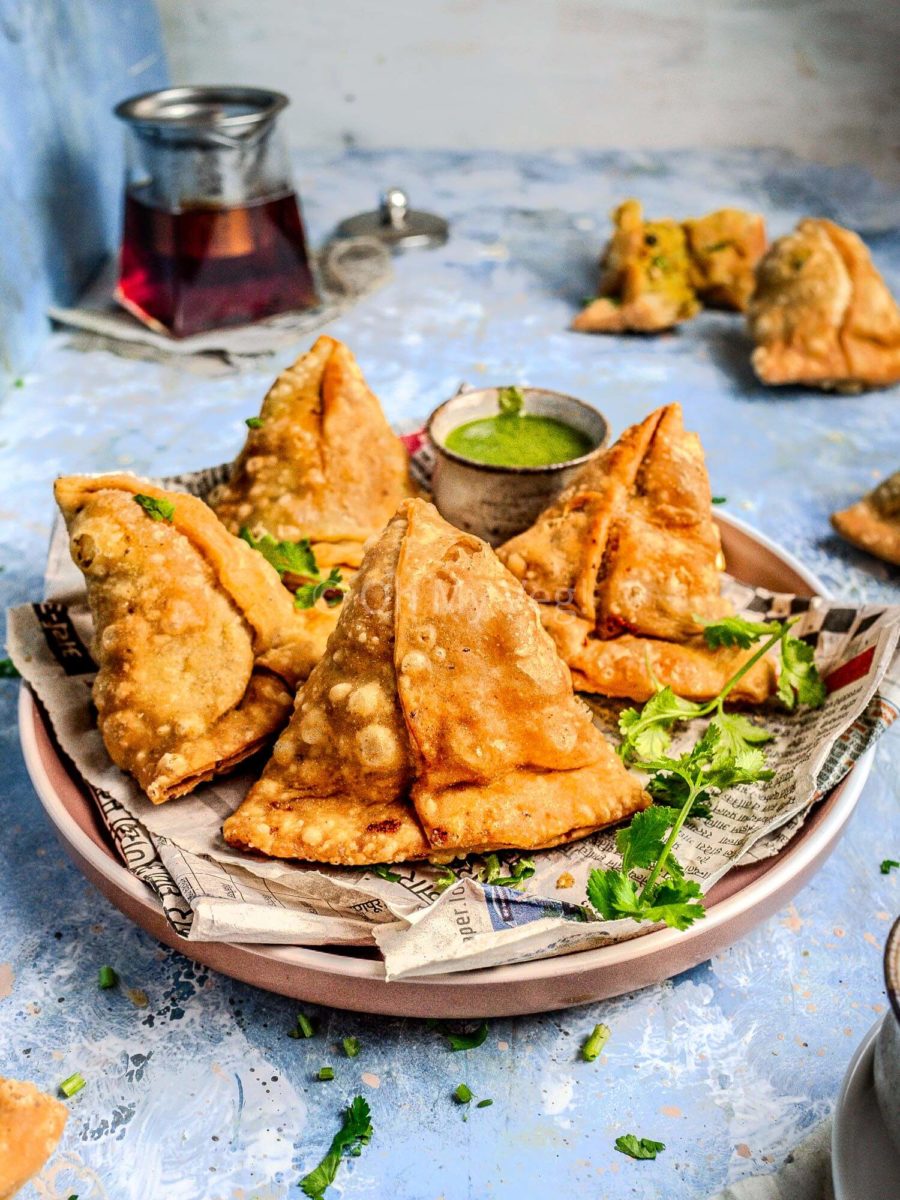
What is Vegetable Samosa?
A sort of “pie,” vegetable samosas are an Indian snack food comprising a spiced filling encased by a flaky outside pastry layer.
If you’re curious about the difference between samosa and Punjabi samosa, it’s the shape. Punjabi samosas are much larger and stuffed to the brink with a filling. Chefs often shape the treats into pyramids, while ordinary samosa can also be flat. Punjabi samosa is also guaranteed to have a crisp homemade pastry, as opposed to filo samosa.
Where Are Vegetable Samosas From?
Etymology suggests that the samosa likely originated in Iran and made its way to India centuries ago during the rule of the Delhi Sultanate. Chefs from the Middle East and Central Asia employed in the kitchens spread the popularity of the delicious snack. However, while samosa gained traction in India, it fell out of favor in Iran.
In today’s culinary landscape, samosas are an unmistakable icon of Indian cuisine, having undergone several adaptations to the original recipe over the centuries and emerged as an Indian mainstay. Plus, thanks to immigration, the Indian samosa has spread far and wide to other areas, including East Africa, the U.S., and the U.K.
So, how come the recipe is called “Punjabi samosa”? Are samosas Punjabi? Well, many regions of India have their own interpretation of the famous samosa: singara in the Eastern Indian states, mince-stuffed Hyderabadi lukhmi, and the most widespread and legendary of all … Punjabi samosa.
What Does Vegetable Samosa Taste Like?
Vegetable samosa tastes heavenly! The filling is warming, hearty, and robust, packed with fiery, earthy, punchy, and zesty spices mellowed out by creamy potato and fresh peas. The pastry is the perfect contrast to the soft filling; crisp and buttery.
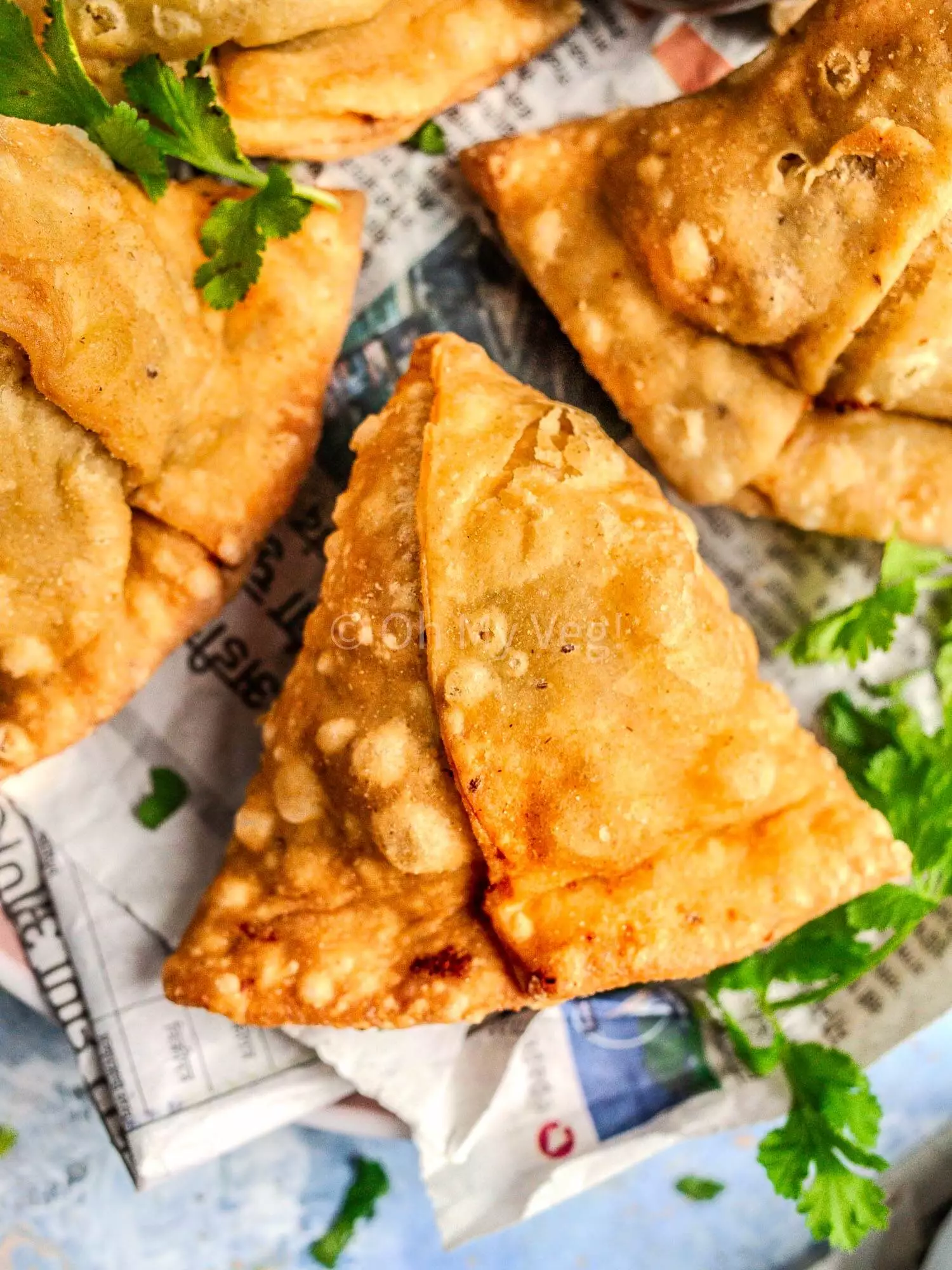
What Are Vegetable Samosas Made Of?
We make Indian vegetable samosa from potatoes and peas tempered with an amazingly fragrant, tempting selection of spices. The ingredients list may seem long, but if you have a pantry stocked with a selection of essential Indian spices, it’s manageable!
What Ingredients Are In Vegetable Samosa?
Let’s go over everything involved in making these tantalizingly scrumptious vegetable samosas! If you’re looking for the complete recipe, including detailed instructions and ingredient quantities, scroll to the recipe card.
For the Vegetable Samosa Dough Recipe
- Plain flour (also called all-purpose flour or maida) is the basis of our homemade samosa dough recipe. Don’t substitute any other flour, including atta; we need superior gluten development for this Punjabi samosa recipe!
- Carom seeds (ajwain) are optional, but I love adding them to my samosa dough. They add a warming, peppery, complex flavour that adds incredible depth to this samosa dough. Crush them between your hands to imbue extra aroma!
- Neutral oil will create a flaky, bubbly, and crisp crust in the samosa pastry.
- Water, just enough to bring the dough together.
- Sea Salt to taste is essential!
For the Vegetable Samosa Filling
- Potato makes up the base of the samosa filling, offering hearty robustness and an ideal mild base for our spicing.
- Green peas add freshness to the filling — plus potatoes with peas is a classic combination. I use frozen peas, but fresh peas work just as well!
- Neutral Oil is a carrier for all the flavours our spices will add.
- Cumin seeds add sweet, warm bursts of flavour.
- Dried pomegranate seeds are a specialist ingredient, but it’s worth seeking. They provide a balanced mix of sweet and sour notes. You can replace them with dried mango powder (amchur) or lemon juice with a pinch of sugar.
- Fenugreek seeds offer a sweet, nutty taste and distinctive maple overtones, essential for that “curry” flavour in a great Punjabi samosa!
- Asafoetida brings a depth of flavour similar to onions or garlic. Just a pinch is enough.
- Onions, finely chopped, contribute a subtle sweetness once cooked.
- Ginger is comforting and warm, with a slightly pungent kick. You can substitute fresh ginger for ginger powder.
- Green chilli adds a fruitier layer of heat that comes in bursts.
- Red chilli powder throughout the samosa filling provides fiery heat in every bite.
- Coriander powder provides fragrant, citrusy notes tinged with earthiness throughout each bite of the samosa.
- Turmeric Powder is musky, earthy, and mildly bitter, but it also adds a gorgeous, vibrant yellow colour to our samosa filling.
- Fresh Coriander adds a zesty brightness reminiscent of citrus, pairing well with all the other spices.
- Sea Salt is vital. You have to season your food!
Vegetable Samosa Allergens
One of the top “selling points” about these delicious samosas (aside from how great they taste, of course!) is how great they are for various dietary needs. That makes them a perfect choice for large gatherings, parties, or potlucks. Trust me, everyone will thank you!
Vegetable samosas are naturally vegetarian, nut-free, and soy-free! Plus, let’s answer two of the other most common allergen concerns for Punjabi samosas:
Are Vegetable Samosas Gluten-Free? No, unfortunately, samosas are not typically gluten-free. We make samosa pastry from wheat flour. However, with a few adaptations, samosa can indeed be suitable for coeliacs or anyone with a gluten intolerance! Simply use gluten-free tortillas to make no-fuss, easy tortilla samosas.
Are Vegetable Samosas Vegan? Yes! Punjabi vegetable samosa is one of the best vegan snack recipes. Both the homemade samosa dough and samosa filling are entirely plant-based, meaning anyone can enjoy the iconic street food — whether you’re an omnivore, vegetarian, or vegan!
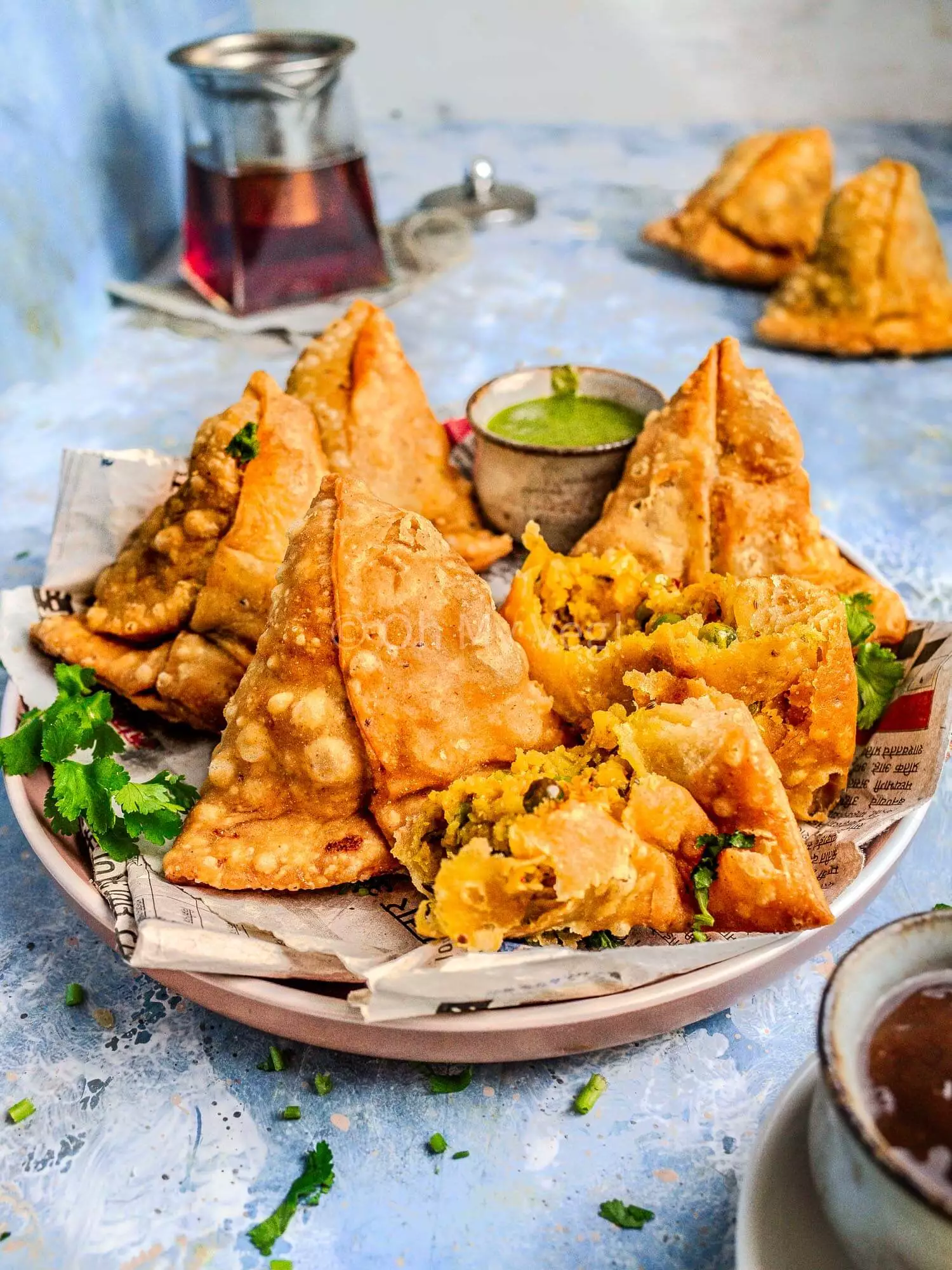
How to Make Vegetable Samosa
Let’s get down to business: how to make vegetable samosa at home. Below is a quick overview of the main steps in this recipe. You will need to dedicate some time to making samosa from scratch, especially if you don’t have experience with Indian cooking.
That said, it’s doable. I broke my recipe into straightforward, easy-to-follow steps, ensuring a street-free cooking experience. For detailed instructions on how to cook vegetable samosa, please scroll down to the recipe card!
- Boil the potatoes, then drain and mash them.
- Make the samosa dough by combining flour, salt, carom seeds, and oil. Rub the mixture together until it resembles breadcrumbs (this technique is called “moan” or “moarn”), then gradually add water, making a tight and stiff dough.
- Make the stuffing by frying the whole spices, onion, ginger, green chilis, and powdered spices. Next, add the mashed potatoes, peas, seasonings, and fresh coriander (cilantro).
- Shape the samosas by rolling out the pastry and adding the vegetable samosa filling — more details below.
- Fry the samosa over medium heat until golden. You can also air-fry or bake samosa. Just keep reading to find out how!
Can You Make Vegetable Samosas Without Frying?
Absolutely, you can make healthy samosas without frying.
While I’ll forever cherish the taste of deep-fried Punjabi samosas, I’ve had great success with baked samosa and even air-fried samosa. They’re perfect for those seeking a healthier samosa option. Let’s delve into how to cook them:
- How to make samosas in the oven: Preheat your oven to 200 C (392 F) and line a tray with baking paper. Arrange your samosas on the tray and spray/brush them with a neutral cooking oil. Bake for around 40 minutes, turning the samosas halfway through cooking if necessary. Ta-da — your baked vegetable samosa is ready.
- How to make samosas in the air-fryer: Preheat your air-fryer to around 180 C (356 F) and spray/brush the samosa with oil. Air-fry for 15-20 minutes or until golden, turning halfway. Your vegetable samosa recipe without deep frying is ready to eat!
How to fold Punjabi Samosa?
If you’re a beginner, folding Punjabi samosas can seem complicated, but it’s actually quite a simple process. Especially with homemade samosa pastry! Let’s dive into it, and if you struggle to visualize the process, refer to the pictures above to help.
- Divide the dough into four pieces and roll them into smooth balls. (Fig 2)
- Roll out one ball into an 8-inch circle. Use plenty of flour along with a chapati rolling pin and board (chakla belan) to help. (Fig 3)
- Cut the circle in half. (Fig 4)
- Fold the samosa by spreading water alongside the straight edge of your semi-circle. Fold one straight edge over the other to make a cone shape. Press the “seam” shut and pinch the tip closed. (Fig 5)
- Stuff the samosa pastry with the filling. Be sure to divide the filling evenly beforehand! (Fig 6)
- Close the edges with your fingers and place it onto a board.
- Repeat the process with the remaining dough. Cover the completed samosas with a cloth to avoid them drying out.
What to Serve With Vegetable Samosa?
- Punjabi samosa chaat is one of my all-time favourite things to do with leftover samosa, but sometimes I make homemade Punjabi samosa just to make chaat. This dish combines smashed samosas with spiced chickpea curry and a myriad of Indian chutneys, like sweetened yoghurt, green chutney, and tamarind chutney.
- Vegetable samosa with mango chutney is a classic combination, especially here in the U.K., where BIR (British Indian Restaurants) serves samosa with a sweet, tangy dip.
- Vegetable samosa with chana is a variation of samosa chaat without the chutneys, featuring just the crispy snack with a lip-smacking chickpea curry.
- Vegetable samosa with raita is another favourite.
- Vegetable samosa with ketchup sounds inauthentic … but you’d be surprised how many street stalls offer the American condiment! The sour, tangy, and sweet flavours of ketchup pair surprisingly well with Indian snacks like samosa and onion bhaji.
- Punjabi samosa with chai is considered one of the best Indian breakfasts ever, alongside poha with chaha with or sabudana vada and a cup of tea.
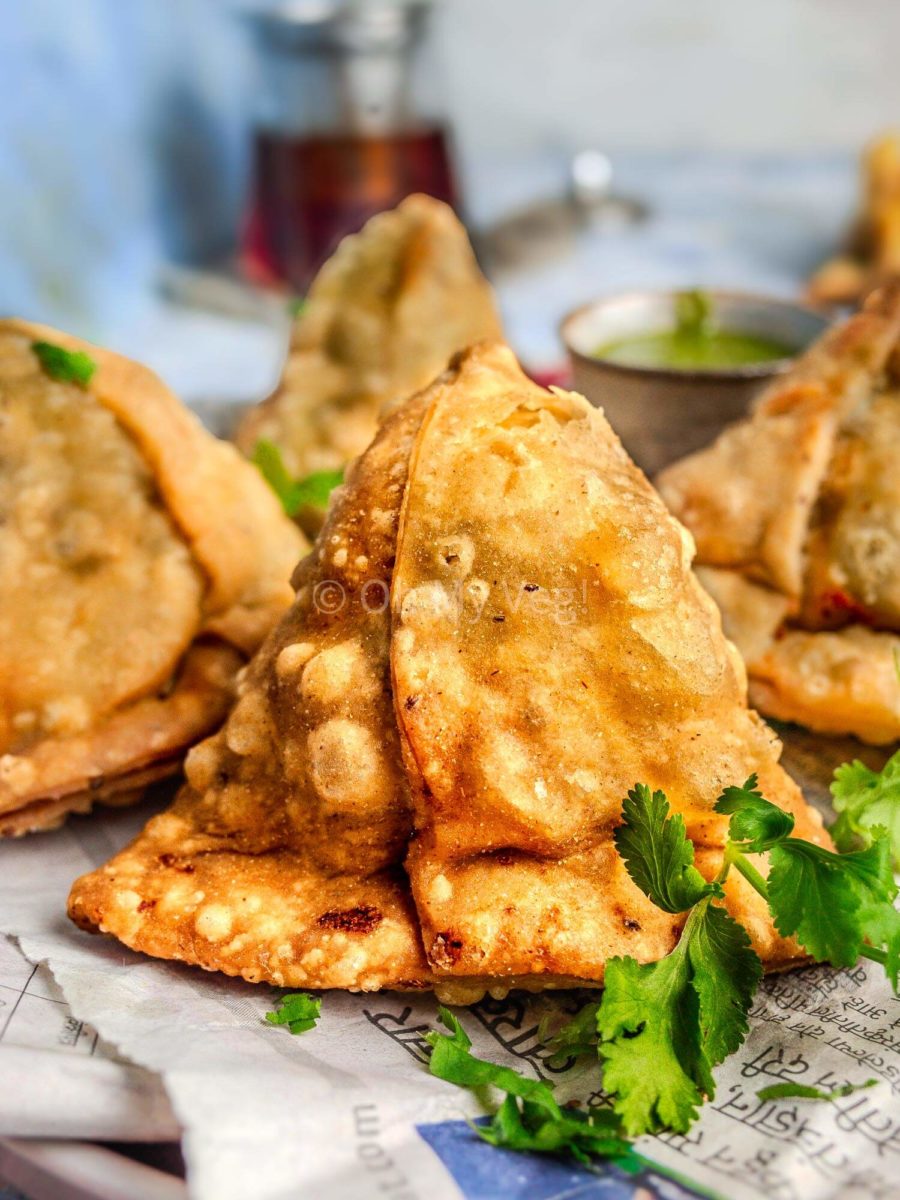
Can Vegetable Samosa be Frozen?
Indeed! You can freeze my vegan samosa recipe — I enjoy preparing extras and storing these snacks in the freezer for a convenient treat. It’s such a luxury to have homemade samosa readily available anytime!
You can freeze either uncooked or cooked samosa. First, freeze the vegetable samosa on a baking tray. Once frozen solid, take the samosa off the baking tray and use a freezer bag instead.
A frozen homemade samosa can last in the freezer for up to six months!
How to Reheat Vegetable Samosa
If you have leftover samosas (I’ve never heard of such a thing!), you’re likely to have frozen them or stored them in the refrigerator. But how can you reheat samosas?
As it turns out, reheating vegan Punjabi samosa is a walk in the park. The best method by far is heating the samosa in a preheated oven for around 10 minutes — resulting in a piping-hot filling and crispy outer pastry. If you have an air fryer, this works just as well!
Avoid microwaving your samosas, which leaves them soggy. Similarly, deep-frying the samosa a second time will make it greasy and oily, which nobody likes! If you don’t want to turn on your oven, the second best option is to heat them in a regular frying pan, turning regularly.
This Recipe Is …
- Authentic and traditional
- Crispy, flaky, and crunchy
- Perfectly spiced
- Non-greasy and non-oily
- Vegan and vegetarian-friendly
Vegetable Samosa, Vegan Punjabi Samosa
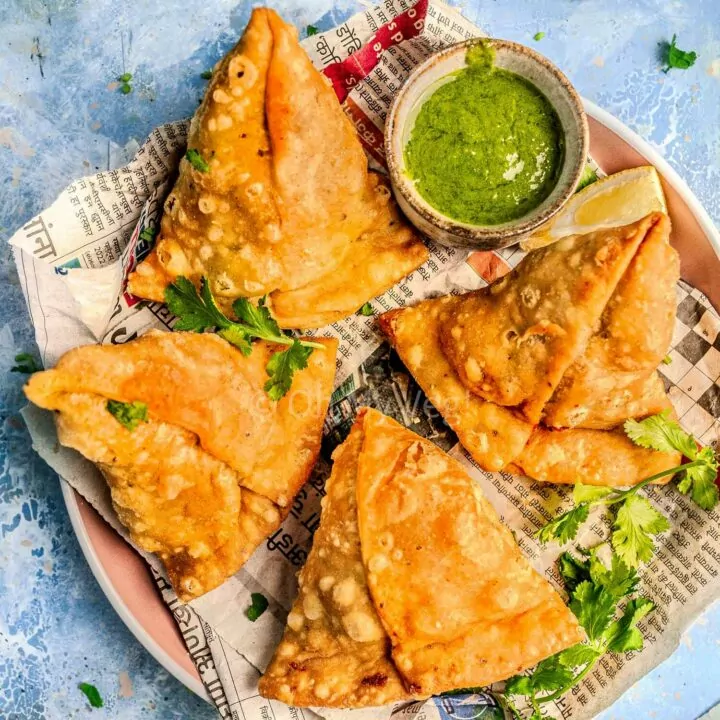
Punjabi vegetable samosas are a beloved Indian snack made from spiced potatoes and peas encased in a crisp, flaky, pastry.
Ingredients
For the Samosa Dough:
- 170g Plain Flour (All-purpose flour/Maida)
- 1/4 tsp Sea Salt
- 1/2 tsp Ajwain (Carom Seeds)
- 4 tbsp Neutral Oil
- 5 tbsp Cold Water
Samosa Stuffing
- ~240g Potato, peeled & roughly chopped
- 1 tbsp Oil
- 1 tsp Cumin Seeds
- 1 tsp Anardana (Dried Pomegranate Seeds), coarsely crushed
- 1/2 tsp Fenugreek Seeds, coarsely crushed
- 1/8 tsp Hing (Asafoetida)
- 40g Onion, finely chopped
- 1 tsp Ginger, finely chopped
- 1 Green Chilli, finely chopped
- 30g Green Peas*
- 1/2 tsp Red Chili Powder
- 1/2 tsp Coriander Powder
- 1/4 tsp Turmeric
- 1/2 tsp Sea Salt
- 4 strands Fresh Coriander, finely chopped
- 40g Coriander/Cilantro
- 2 Green Chili
- 1/4 Lemon, juiced
- 140ml Water
Instructions
- Boil the potatoes, in a large saucepan with plenty of water on medium-high heat until knife soft. Drain the potatoes, then roughly mash them — some lumps are fine.
- Make the samosa dough by combining flour, salt, carom seeds, and oil. Rub the mixture together until it resembles breadcrumbs (this technique is called “moan” or “moarn”), then gradually add water, making a tight and stiff dough. Cover the dough and let it rest for 20 minutes while you make the samosa filling.
- Make the stuffing. Add oil to a large pan over medium heat. Once the oil is hot, add the cumin seeds, crushed anardana seeds, fenugreek seeds, and hing. Sauté for a few seconds then add the onion, ginger, and green chilis, cooking for one minute. Next, add the ground spices and peas. Mix well and add the mashed potatoes along with salt and fresh coriander. Stir the mixture together and turn off the heat. Roughly separate into eight portions.
- Shape the samosas. First, divide the dough into four pieces and roll them into smooth balls. Then roll out one ball into an 8-inch circle. Use plenty of flour along with a chapati rolling pin and board (chakla belan) to help. Cut the circle in half and fold the samosa by spreading water alongside the straight edge of your semi-circle. Fold one straight edge over the other to make a cone shape. Press the “seam” shut and pinch the tip closed. Finally, stuff the samosa pastry with the filling. Close the edges with your fingers and place it onto a board. Repeat the process with the remaining dough. Cover the completed samosas with a cloth to avoid them drying out.
- Fry the samosa over medium heat until golden, around seven minutes. Don't overcrowd the fryer and drain on kitchen paper once fried. You can also air-fry or bake samosa. See the notes below to find out how.**
Serve the vegetable samosa with chickpea curry, green chutney, raita, tamarind chutney, ketchup, or mango chutney.
Notes
* Fresh or frozen peas both work fine, so pick whichever is convenient for you.
** To bake or air-fry samosa, read the below instructions:
- How to make samosas in the oven: Preheat your oven to 200 C (392 F) and line a tray with baking paper. Arrange your samosas on the tray and spray/brush them with a neutral cooking oil. Bake for around 40 minutes, turning the samosas halfway through cooking if necessary. Ta-da — your baked vegetable samosa is ready.
- How to make samosas in the air-fryer: Preheat your air-fryer to around 180 C (356 F) and spray/brush the samosa with oil. Air-fry for 15-20 minutes or until golden, turning halfway. Your vegetable samosa recipe without deep frying is ready to eat!
Recommended Products
As an Amazon Associate and member of other affiliate programs, I earn from qualifying purchases.
Nutrition Information:
Yield:
8Serving Size:
1Amount Per Serving: Calories: 203Total Fat: 9gSaturated Fat: 1gTrans Fat: 0gUnsaturated Fat: 8gCholesterol: 0mgSodium: 240mgCarbohydrates: 26gFiber: 2gSugar: 2gProtein: 5g
Nutrition information isn’t always accurate.

